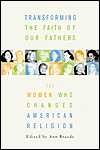
“If you were born after 1965,” Ann Braude writes in her introduction, “you may not remember when inclusive language was unknown, when a woman minister was a curiosity, when brides routinely vowed before God and family to ‘obey’ their husbands. . . These changes, and the new world they herald, did not come about by themselves.” (p.1) The generation that has practically memorized the rituals in The Spiral Dance, worn out copies of Patricia Monaghan’s Book of Goddesses & Heroines and read and reread the works of Marija Gimbutas and Z. Budapest probably don’t remember when no one had ever heard of a goddess, when the standard-brand religions were all there were. Braude, who is Director of the Women’s Studies in Religion Program at Harvard Divinity School, asked sixteen women to tell their stories. Most of the women are Christian, Jewish or Muslim. (The only two of “our” women in the book are Carol P. Christ and Vicki Noble.) And what stories these women tell! They’re senior citizens now, but they’re still ready to fight for their (and our) rights. The idea of empowering women in religion was a new idea when they became active in their work. They haven’t finished that work. As Lois Miriam Wilson, first woman moderator of the United Church of Canada, writes, “Feminists need a different wardrobe if we intend to transform the future. We need goggles that will enable us to see the world at 180 degrees, as it really is. We will need flippers for our feet as we swim against the current. We will need to know how to practice resistance. . . Instead of ‘Sugar and space and everything nice . . .’ try ‘Subversive and strong, the whole day long, that’s what little girls are made of!’” (p. 29) We read the stories of women whose names we may recognize: Letty Cottin Pogrebin, cofounder of Ms. magazine; Rosemary Radford Ruether, Catholic feminist theologian; Elizabeth Schussler Fioenza, feminist biblical scholar; Judith Plaskow, Jewish feminist theologian. We also hear from women like Virginia Ramey Molenkott, who says she had to learn to trust herself. “Not only did I have to transcend the teaching that my core self was deceitful, desperately wicked, and totally untrustworthy,” she writes, “I had also been taught at Bob Jones University that female thought processes are naturally inferior. (p. 63) Delores S. Williams, a womanist theologian, tells how she had to overcome racism as well as sexism in religion. Margaret M. Toscano, cofounder of the Mormon Women’s Forum, tells how she asserted the rights of women to the Mormon priesthood and (as late as 2000) was excommunicated. Here are sixteen inspiring stories of women who decided to swim against the patriarchal tide and claim feminine power when feminism was just being invented. Today, with a backlash against empowered women, their stories are more important than ever. We need to know what our pioneers did— in “the olden days” of only thirty or forty years ago— and how they struggled for rights that are in danger again today. This is the book we should hand to our daughters, nieces and younger coworkers. You see, we can tell them, if we don’t know our history, we really may have to repeat it. It’s not a question of liberal or conservative ideology or pagan or fundamentalist religion. The all-important issue is human rights, both inside the churches and outside them. ~ review by Barbara Ardinger, Ph.D.Ann Braude, editorPalgrave Macmillan 2004261 pages, $27.95
